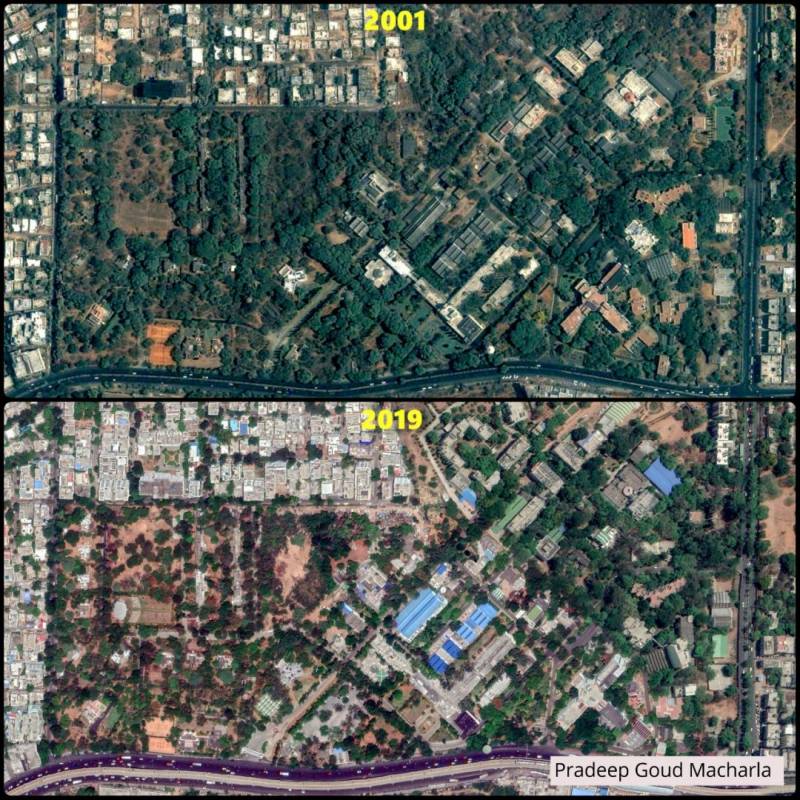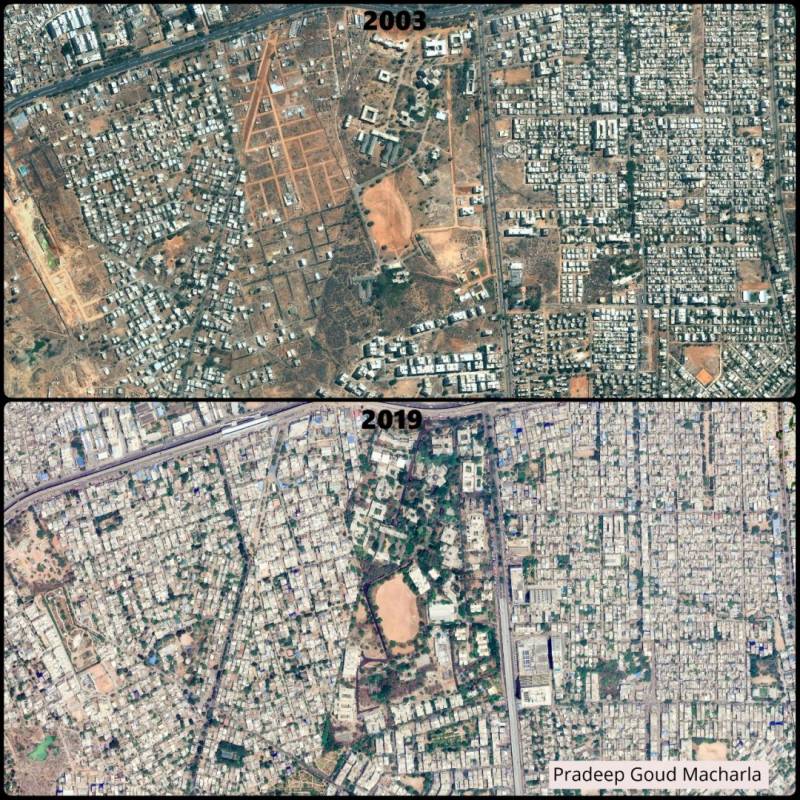Satellite images raise concern for green cover in Hyderabad's KPHB and Tarnaka
By Dheeshma
Hyderabad: A satellite image comparison of Kukatpally Housing Board Colony region, Hyderabad shows unprecedented urbanisation in the area. KPHB, also known as little Andhra, receives hundreds of migrant workers from Andhra Pradesh every year.
Satellite images of Tarnaka from 2001 and 2019 also show Hyderabad’s disappearing green cover. A comparison reveals that the scenario is the same for institutions like the Indian Institute of Chemical Technology (IICT) and Centre for Cellular and Molecular Biology (CCMB). Even institutes are not spared when it comes to development in the city.
P Udaykrishna, the founder of Vata Foundation, told NewsMeter that when SRDP project was happening in Kukatpally in 2017, more than 200 trees were lost at a stretch from the main road. “We could save only 100 of them through replanting. There was no compensatory plantation in the area. Today, the footpath doesn’t have any trees. That was a clear failure of the Tree Conservation Committee. They are the ones responsible for making sure that three to five trees are planted in place of every tree cut. They also have to ensure that these trees grow back into greenery. However, that hasn’t happened anywhere,” he said.
There was a water body next to Kukatpally MMTS station, which is almost filled up today. So not just the greenbelt, the region is also losing its water bodies.
KPHB is supposed to be Asia’s largest housing-board colony. Therefore, there would have been enough planning for greenery as well. The issue could have used some proper execution. “The connecting road from JNTU to Hi-Tec city came during the early 2000s. Since then, development in Kukatpally took off. Even today, a lot of construction is going on to a huge extent without any planning for greenery,” Udaykrishna said.
He added that IDL Explosives Limited, which has some greenery in its campus, is also moving out for development. “So the little greenery which is left in their patch will also vanish.”
However, GHMC has taken up some good plantation work across the road connecting Moosapet and Hi-Tec city. Apart from that, there is not much greenery in the area. Meanwhile, sustainable development that meets society’s needs is always a challenge. Densification and multiplication of already earmarked lands of development are evident from the satellite images.
Anant Maringanti, director of Hyderabad Urban Lab Foundation, told NewsMeter that housing is still unaffordable for many people in Cyberabad’s core area. “Over 20 years, independent houses featuring little greenery and proper drainage system in Pragathi Nagar in Kukatpally have turned into flats. That is where many Hi-Tec city employees now live. People who had 200 or 300 sq feet area plot teamed up with their neighbour who has a similar plot and built a ten-flat apartment complex instead of two independent bungalows.”
Maybe one can say that this is a bad way of development, but according to Mr Maringanti, that’s not a very sustainable argument to be made. He also opines that the city is on the verge of facing a public health problem. “Where else do you expect people to go?” he asks.
He adds that our government is anyway pushing for densification of cities. “People need things, and they take what is available. The problem with densification is not that more people are living in a smaller area. The problem is that in terms of water and waste, you have a drainage system being damaged by the sewage from all these houses. At some point, this will turn into a public health problem.”
Each individual can maximise only what is right for him or her. “Since the state does not have much control over land and development, in such a situation, designated common lands are going to shrink further. We should talk about water, trees, and green cover but that has to be done together with a deeper understanding of what people need,” Maringanti opines.
Similar to Kukatpally, water bodies in Tarnaka were also not spared along with its greenery. Maringanti said, “In Tarnaka, two lakes have disappeared at the cost of development. They were two interlinked tanks, Erakunda and its connected system. In the mid-90s, the two lakes were encroached, and there was a long-term court case. However, once the court case was settled, many encroachments started coming up. They produced several documents claiming that it’s a private tank and not public property.”
 2003 and 2019 satellite images of KPHB, Hyderabad
2003 and 2019 satellite images of KPHB, Hyderabad
Apart from Kukatpally, Patancheruvu and Miyapur are two areas that are densely populated by employees from Hi-Tec City. They travel 15km every day to Hi-Tec city.
According to experts, Hyderabad lacks a good sense of public or community areas. The public spaces in the city are never protected.
Dr Ramachandraiah, a professor in Urban Studies, Centre for Economic and Social Studies (CESS) told NewsMeter that the city’s master plan for KPHB had not earmarked specific places for greenery. “Based on the density of the population, thinly populated areas need to be earmarked as lung spaces, and they should never be converted for residential uses. In the absence of that, people will start talking about greenery in areas where people are living. In KPHB, today, the greenery that you might find is nothing but shrubs, vacant areas, and not trees. They are not designated parks. When every bit of land is privatised or sold, it goes on becoming concrete.”
Regarding the institutions in Tarnaka that lost its greenery, Dr Ramachandraiah said, “When institutions like IICT and CCMB were set up, there were many vacant areas in that belt. Over the years that land was given to other institutions that came up later, such as Hyderabad Central University. The latter had to give away its land to IIT, Gachibowli Stadium and RTC deport.”